They call us “The Sandwich Generation” —the group of workforce-aged adults who are not only caring for their aging parents, but also balancing the needs of their own children.
It might be hard to understand the term until you experience it firsthand.
When my father-in-law had an unexpectedly difficult time recuperating from surgery last summer, I was stunned at just how upside-down it turned our lives.
If you’ve been through the prolonged hospitalization (or any other intense, sustained medical treatment) of a family member, you know: You may become an honorary nursing aide—or at least a frequent overnight guest at the medical facility.
It’s quite an adjustment, especially when the anxiety sets in: How will I be able to get back to work?
Having the privilege of a self-directed, flexible workplace provided a bit of peace during months of stress and uncertainty.
Many of us are facing this work-care challenge
According to the AARP, 61% of those who provide care for a family member older than 50 are also balancing employment, and half of today’s workforce expects to provide care for aging family members in the next five years.
61% of caregivers report making work accommodations because of caregiving, with the most common adjustment being changes to one’s work schedule: arriving late, leaving early, or taking time off during the day.
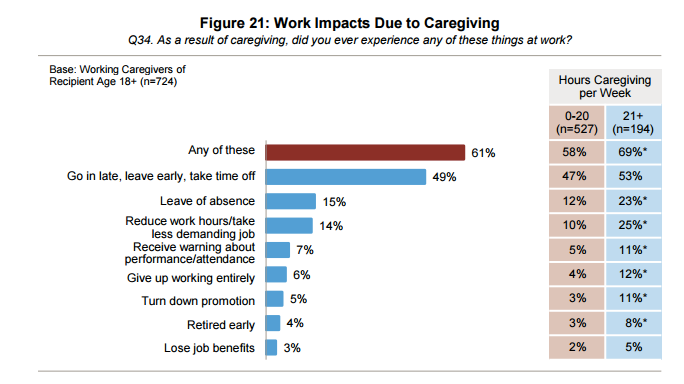
Even small reductions in work hours can have long-term consequences on retirement security, benefits, health insurance, and job security. As many as 43% of people caring for their parents say that their professional career has suffered as a result of caregiving.
If we can create more flexible work options, the growing workforce whose parents are living longer can balance family obligations with work responsibilities in a creative and productive way.
There are many solutions that companies can explore in order to create more flexible work. Depending on the type of position and responsibilities, there is a flex strategy that will fit nearly every employee’s needs. Here’s a look at five flexible work strategies, and some of the companies that employ them.
5 flexible work solutions (and the companies that use them)
Flexible work strategy 1: Unlimited vacation
Who’s using it: Mammoth HQ, LinkedIn, FullContact, Netflix, Evernote
Many companies are implementing an unlimited or “take what you need” policy regarding vacation. Although it may sound ripe for misuse at first glance, this policy can fit well in an organization that operates on mutual respect and trust.
If a company has already conducted careful character and talent reviews when hiring, and employees are working in roles that complement the team culture, it should already be assumed that employees are making decisions in the best interests of the company.
This graphic from the Society for Human Resource Management includes some tips for deciding if an unlimited vacation policy is right for your organization.
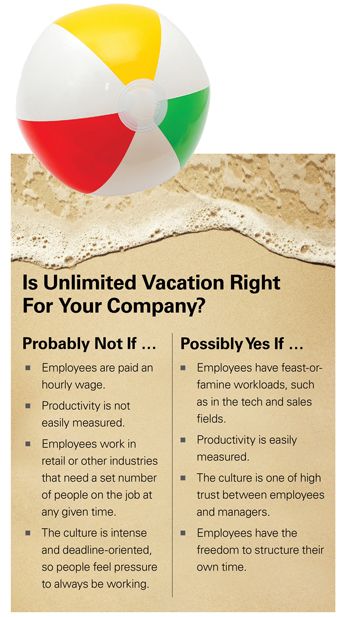
Because many services and organizations operate in a fixed location, unlimited vacation can be one of the best flexibility strategies to offer employees who face significant, but temporary, family upheaval.
Mammoth HQ is one company that offers unlimited vacation, and they shared their biggest lesson with Fast Company:
“Be ready to shift your focus from the clock to contribution. Turning the clock off begs the questions: How much work is enough, and how much time off is too much? Managers and employees alike need tools for defining and communicating an employee’s expected contribution, so employees can manage their schedules and their managers can evaluate and guide their performance.”
Flexible work strategy 2: Results-Only Work Environment
Who’s using it: MindTools, American Society of Clinical Oncology, some departments of GAP
The Results-Only Work Environment, or ROWE, concept, was developed by Cali Ressler and Jody Thompson and published in the book Why Work Sucks and How to Fix it.
The ROWE concept means that team members are measured by performance, results, or output—rather than physical presence in an office or number of hours worked. Here’s a look at some of the keys of the ROWE system:
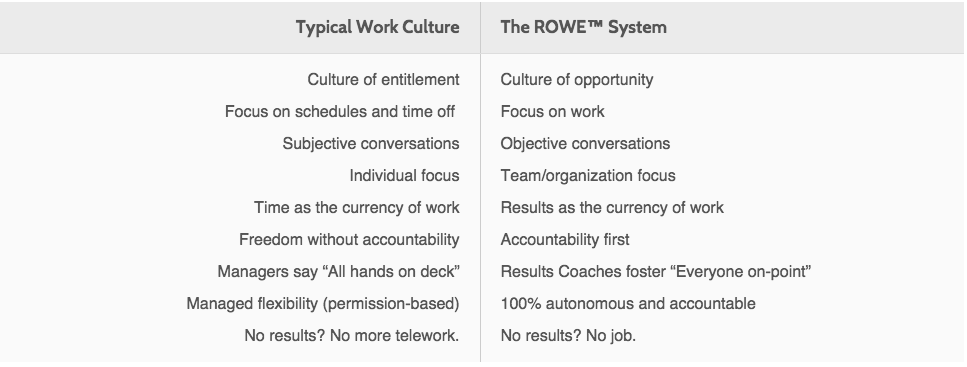
A ROWE workplace can serve to enable flexibility for all types of employees—those who must attend daytime appointments, those who seek to avoid heavy commute times, or those who are trading off family caregiving with partners.
The team at MindTools uses ROWE and advises that consistently setting clear, measurable goals is one of the best ways to keep the entire organization committed to this type of productive flexibility.“The focus is on results and goals. This means that team members are clear about what they need to achieve, and how this contributes to the organization’s objectives as a whole.”
Sean Kim of The Growth List says a
focus on output is key : “At the end of the day, the output that we produce is the only tangible result we can present that brings the business forward.”In the case of knowledge workers and the creative class, it’s difficult to believe that going into the office is the only way to create productive work. A shift to ROWE could become commonplace at such organizations in the future.
Flexible work strategy 3: Remote work and distributed teams
Who’s using it: FormAssembly, Sqwiggle, HelpScout
The ability to work remote is on the rise. The Wall Street Journal shared the chart below based on a 2013 report from the U.S. Census bureau:

And this change is redefining family and community structure. Parents can opt to stay at home to co-participate in household and childcare obligations. The spending habits of a new generation of Millennials are reflecting a focus on efficiency and fulfilling experiences.
“We’re so comfortable with facilitating virtual communication that we can truly work anywhere,” shared Shira Beder
at FormAssembly. “We embrace and love collaborative technology. We’re results-oriented, more independent, and adaptable because we have no other choice if we want to stand a chance in the highly competitive job market and rapidly changing times.”Communication software company Sqwiggle
builds tools that keep remote teams connected . Their philosophy: “Remote working is about freedom. We enjoy having a physical and social connection with the ones we work with, but this usually means being forced to commute to an office and being shackled to a desk from 9 to 5.
The future of remote working is about maintaining these social positives that come with the office setting while enabling the freedom that comes with being able to work where you want.”
When
setting up a remote workforce , communication and an intentional atmosphere of open, transparent dialogue and access to information is considered one of the most important aspects in the value proposition.HelpScout, a large, distributed team that creates help desk software, gives this advice in understanding how to support team members and create a positive remote work culture:
“The best way to measure the success of your remote culture is through empathy. Work from home for a week, then talk to the remote people on your team, and you’ll get an idea of what can be improved.”
Flexible work strategy 4: Time agnostic work
Who’s using it: FlexJobs, CloudPeeps
Work can sometimes require an interruption to the traditional 9-to-5, whether it’s to nurture one’s own personal health or to take time off to provide care to others.
The modern workforce is increasingly made up of people who have evaluated their lifestyles and identified their unique productivity rhythms, dietary needs, and flow states.
Traffic patterns, school schedules, and family obligations also factor in as we evaluate which parts of the day are most favorable for getting work done.
If remote work isn’t quite a workable solution, employers can offer flexibility regarding when employees can put in their work. Scheduling with a bias toward flexibility can help to retain the best and most loyal team.
There are a number of ways to add flexibility into employees’ schedule. Work Flexibility lists a few here:
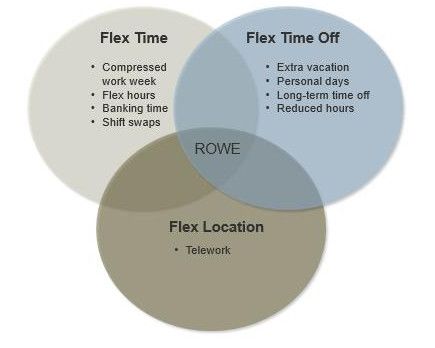
“When workers have control over their own schedules, it results in lower levels of stress, psychological distress, burnout, and higher job satisfaction,” researchers have discovered.
as reported by Bloomberg.People who are in tune with their daily habits understand which elements create more stress and what time of the day offers the best opportunity to be creative, which means flexible work can also create opportunities for more exceptional work.
A thought leader in this space, FlexJobs
offers tips on creating a flexible work proposal form in order to allow employees to express their needs thoughtfully and directly.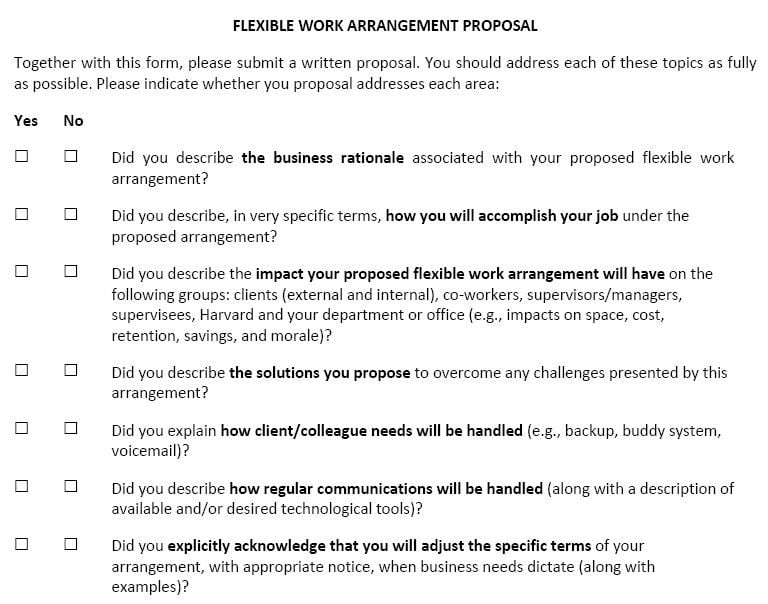
Flexible work solution 5: Job sharing
Who’s using it: US federal government, Qualcomm
Finally, job sharing programs are one of the most common ways for specialized professionals to create the time needed to care for their personal needs in addition to performing excellent work.
A job share team is formed by two professionals who form a partnership to perform one job. An example work week might involve Teammate A working Monday – Wednesday and Teammate B working Wednesday – Friday at the same position, with some handoff and complementary responsibilities on the overlap day.
Job sharing is a great solution to the “brain drain” and other loss of organizational intelligence that occurs when highly experienced workers must face leaving the workforce due to personal obligations. Two professionals who can join together to offer a company their combined experience is one of the best ways to prevent a distraction from the company’s directives.
The US federal government has promoted job sharing as an opportunity within its departments to offer flexible employment to those who need more alternatives in taking care of their families, pursuing education, or for those who have other reasons for desiring part-time work. Several state legislatures are reviewing bills that will require more flexible options for employees.
Which solutions work best for you?
For decades, employers have worked to create family-friendly policies to help alleviate the stress of balancing work and family. But now, we’ve got to consider even more creativity as we realize how many employees face the necessity of caregiving for their parents as well.
And the good news is, these more flexible options can benefit all workers, from every walk of life and situation. It’s something a lot of us are looking for at work, according to many surveys like this one:
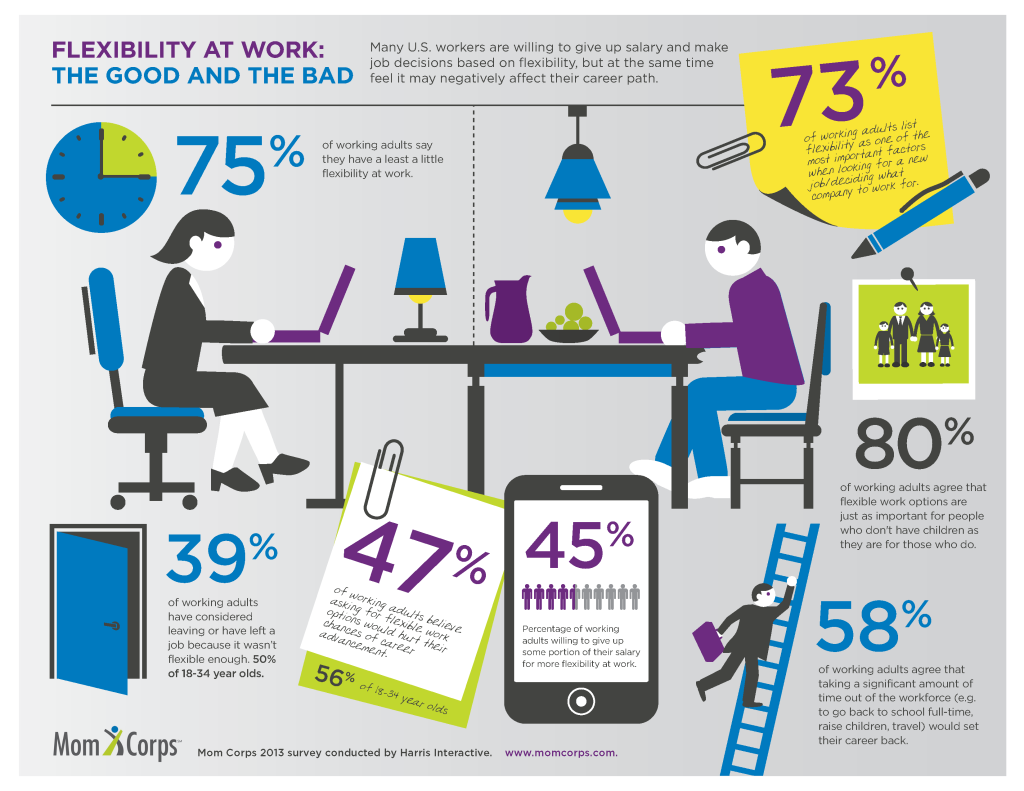
If you’re balancing work and family or the caregiving of an aging family member, or are simply interested in flexible work, I’d love to hear from you.
What flexible arrangements are most important to you? Have you found that the workday is improved by focusing on results, rather than time spent in an office?
Try Buffer for free
190,000+ creators, small businesses, and marketers use Buffer to grow their audiences every month.


